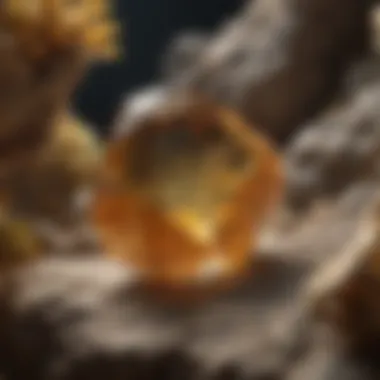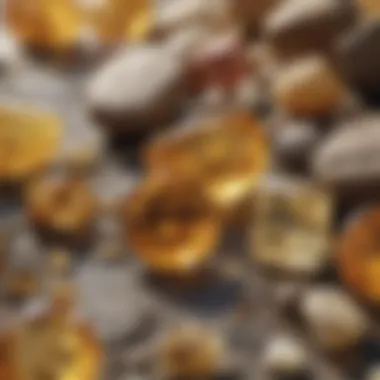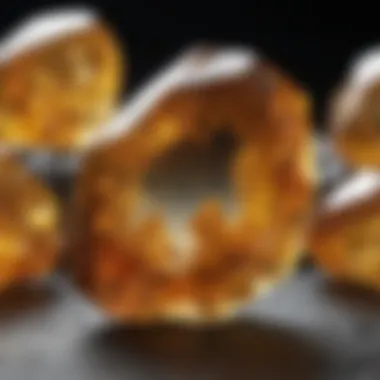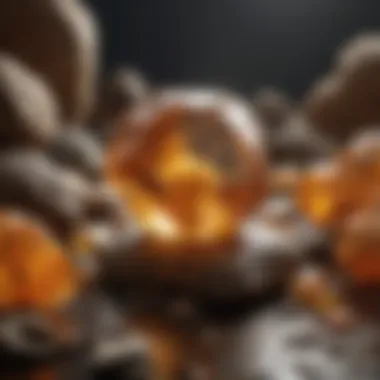Unveiling the Secrets of Genuine Citrine: A Collector's Definitive Guide


Rock and Fossil Identification
Citrine, a captivating gemstone with a warm golden hue, holds a unique allure for rock and fossil collectors. To distinguish genuine citrine from artificial replicas, it is essential to understand the key characteristics and techniques that define authenticity. Authentic citrine is renowned for its distinct color, a pale to golden yellow hue that sets it apart from its heated amethyst counterpart. Moreover, genuine citrine often displays natural inclusions and a subtle translucency that enhances its beauty. As rock and fossil collectors delve into the world of citrine, honing their observational skills and familiarizing themselves with these distinguishing features is paramount.
Collecting Tips and Techniques
For enthusiasts eager to enhance their collection with authentic citrine specimens, employing best practices is imperative. When embarking on a quest to locate prime citrine collecting sites, research plays a crucial role. Regions known for producing citrine include Brazil, Madagascar, and Zambia, offering ample opportunities for exploration. Safely extracting specimens requires precision and patience to avoid damaging the delicate crystals. Utilizing tools such as chisels, brushes, and protective gear ensures a careful extraction process that preserves the specimen's integrity.
Preservation and Display
Once collectors have acquired their prized citrine specimens, preserving them properly becomes a top priority. Techniques such as gentle cleaning with a soft brush and mild soap help maintain the gemstone's luster without causing damage. Proper storage methods involve storing citrine away from direct sunlight and harsh chemicals, safeguarding its color and vibrancy for years to come. In terms of display, enthusiasts can get creative by showcasing citrine in shadow boxes, alongside informative labels detailing each specimen's origin and unique features.
Geological Insights
Delving deeper into citrine's geological origins unveils a fascinating narrative of Earth's natural processes. Citrine forms in association with quartz, primarily deriving its color from traces of iron within the crystal structure. The gemstone's formation in igneous and metamorphic rocks provides insight into the intricate geological forces at play. Historically, citrine has been prized for its symbolic significance in various cultures, believed to embody prosperity and positive energy. Notable discoveries of citrine in substantial sizes have captivated the world, showcasing the beauty and rarity of this exquisite gemstone.
Introduction
In the realm of rock and fossil collecting, the quest for authenticity is paramount. Aspiring collectors and seasoned enthusiasts alike navigate a landscape where determining the genuine from the counterfeit is a skill honed through knowledge and experience. This comprehensive guide on identifying authentic citrine serves as a beacon of insight, shedding light on the nuanced world of gem verification. By exploring the key characteristics and techniques crucial to distinguishing real citrine from imitations, collectors can elevate their expertise and safeguard the integrity of their treasured collections.
Overview of Citrine
Formation Process
Within the intricate tapestry of citrine's origins lies the mesmerizing formation process that gives birth to this exquisite gemstone. Delving deep into the heart of how citrine is brought into existence unveils a captivating narrative of geological forces at play. From the gradual crystallization within the Earth's crust to the transformational journey towards gem-quality status, the formation process encapsulates the essence of citrine's natural evolution. This engrossing aspect of citrine's genesis not only adds allure to its mystique but also showcases the meticulous craftsmanship of nature, crafting each citrine gem with unparalleled uniqueness and distinction.
Color Variations


A kaleidoscope of hues dances within the core of citrine, showcasing a vibrant spectrum that captivates the eye and enchants the soul. Within citrine's color variations lie subtle nuances that unveil stories of geological richness and mineral intricacies. From sun-kissed yellows to amber glows, the captivating array of colors in citrine serves as a testimony to the diverse palette painted by nature's brush. Each color variation carries its own significance, with shades ranging from pale pastels to deep amber tones, offering collectors a tapestry of choices to enrich their collections.
Significance of Authenticity
Value Preservation
Preserving the intrinsic value of citrine extends beyond its monetary worth; it embodies a commitment to honoring the integrity and legacy of each gemstone. Value preservation in citrine underscores the importance of safeguarding its natural beauty, quality, and authenticity. By upholding the standards of genuine citrine, collectors ensure that each piece retains its historical significance and inherent value, enhancing its allure for generations to come.
Collecting Integrity
In the delicate dance of rock and fossil collecting, integrity stands as the cornerstone of every collection. Upholding the principles of collecting integrity signifies a dedication to honesty, transparency, and respect towards the treasures of the Earth. By fostering a culture of integrity within the collecting community, enthusiasts and experts alike contribute to the sustainability and longevity of the field, nurturing a space where genuine passion and reverence for nature's treasures flourish.
Physical Characteristics
In this article on identifying authentic citrine, a thorough exploration of the physical characteristics holds significant importance. Understanding the physical attributes of citrine is vital for collectors as it aids in distinguishing genuine from fake specimens. By focusing on aspects such as color, transparency, texture, and surface features, collectors can enhance their expertise and ensure the integrity of their collections. Examining the physical characteristics offers valuable insights into the quality, value, and authenticity of citrine specimens, making it a cornerstone in the identification process.
Color and Transparency
Natural Hues:
Delving into the natural hues of citrine provides collectors with essential information for differentiating authentic specimens. The unique color variations in citrine, ranging from pale yellow to deep amber tones, play a crucial role in identifying its authenticity. Natural hues reflect the gemstone's purity and transparency, with variations indicating the presence of specific minerals during formation. Collectors value citrine for its warm and vibrant colors, making natural hues a sought-after choice for rock and fossil enthusiasts. The distinct golden glow of natural citrine hues exudes elegance and charm, adding to the appeal and desirability of these specimens.
Clarity Levels:
Exploring the clarity levels of citrine sheds light on its overall quality and visual allure. The transparency and clearness of citrine crystals are key indicators of authenticity, as genuine specimens exhibit high clarity levels. Collectors appreciate citrine for its pristine clarity, which allows light to pass through and enhance its brilliance. Clarity levels influence the gemstone's value and aesthetic appeal, making it a preferred option for discerning collectors. The flawless beauty and transparency of citrine crystals amplify their allure, making them ideal additions to any rock and fossil collection.
Texture and Surface Features
Smoothness:


Assessing the smoothness of citrine surfaces is integral to determining authenticity and quality. The tactile experience of touching citrine specimens provides valuable insights into their texture and finish. Smooth surfaces indicate well-polished and expertly crafted citrine specimens, enhancing their visual appeal and appeal to collectors. The velvety smoothness of citrine surfaces adds a luxurious feel to the gemstones, making them highly desirable among rock and fossil enthusiasts. Collectors admire the silky-smooth texture of citrine, which elevates their tactile experience and appreciation of these stunning gemstones.
Inclusions:
Examining inclusions in citrine unveils unique characteristics and natural formations within the gemstones. Inclusions are internal features that offer clues about the gemstone's origin, growth process, and authenticity. While some inclusions add character and uniqueness to citrine specimens, excessive inclusions may affect their quality and value. Collectors value citrine with tasteful inclusions that enhance the gemstone's charm and appeal, making each specimen truly one-of-a-kind. Understanding the nature of inclusions in citrine enriches collectors' perspectives and appreciation of these fascinating gemstones.
Authenticity Tests
In the realm of identifying authentic citrine, the significance of conducting authenticity tests cannot be overstated. These tests serve as the cornerstone for distinguishing genuine citrine from their counterfeit counterparts. By delving into specific elements and meticulous considerations regarding authenticity tests, rock and fossil collectors can ensure the integrity and value of their collections. Authenticity tests provide a scientific and methodical approach to validating the legitimacy of citrine specimens, offering collectors a comprehensive toolkit to make informed decisions.
Scratch Test
Hardness Check
The hardness check is a vital component of the scratch test, playing a crucial role in the overall evaluation of citrine authenticity. Characterized by its ability to assess the resistance of citrine to scratching, the hardness check is a popular choice in the realm of gemstone identification. Its key characteristic lies in its ability to determine the relative hardness of citrine compared to other minerals, helping collectors gauge the durability and authenticity of their specimens. The unique feature of the hardness check is its simplicity yet effectiveness in providing valuable insights into the genuineness of citrine, making it a preferred method in this article.
Scratch Resistance
Scratch resistance is another essential aspect of the scratch test, contributing significantly to the overarching goal of authenticating citrine specimens. This specific test evaluates the ability of citrine to withstand scratches and external pressure, offering collectors insights into the gemstone's durability and toughness. The key characteristic of scratch resistance lies in its ability to reflect the quality and authenticity of citrine based on its reaction to abrasive forces. Its unique feature includes providing a tangible measure of the gemstone's resistance to wear and tear, guiding collectors in their quest for genuine citrine in this article.
Light Test
Translucency Assessment
Within the light test category, the translucency assessment plays a critical role in elucidating the authenticity of citrine specimens. This test focuses on evaluating the degree of light transmission through the gemstone, shedding light on its clarity and purity. The key characteristic of translucency assessment lies in its ability to reveal internal flaws or inclusions that may impact the overall quality of citrine. Collectors benefit from this method as it provides a clear indication of the gemstone's transparency and authenticity, offering valuable insights into their collections in this article.
Color Reaction


Another crucial aspect of the light test is the color reaction, which helps collectors discern the true nature of citrine through its response to light exposure. This test highlights how citrine interacts with different light sources, unveiling its inherent color properties and characteristics. The key characteristic of color reaction lies in its capacity to showcase the unique hues and tones of citrine, allowing collectors to authenticate the gemstone based on its color consistency and vibrancy. Its unique feature includes providing collectors with a visual indicator of citrine authenticity, enhancing their ability to make informed decisions in this article.
Temperature Test
Thermal Conductivity
The temperature test, specifically thermal conductivity assessment, plays a pivotal role in evaluating citrine authenticity through its response to heat. Thermal conductivity tests measure the gemstone's ability to conduct heat, offering insights into its molecular structure and composition. The key characteristic of thermal conductivity lies in its accuracy in distinguishing between genuine and synthetic citrine based on their thermal properties. Its unique feature includes providing collectors with a scientific method to assess the authenticity of citrine, enabling them to make informed decisions about their collections in this article.
Expert Insights
In this section on Expert Insights, we delve into the pivotal role that expert opinions play in the realm of authentic citrine identification for rock and fossil collectors. Expert insights serve as a beacon of knowledge, guiding collectors towards making informed decisions in their acquisitions. By leveraging the expertise of professionals in the field, collectors can gain valuable understanding and ensure the integrity of their collections. Expert opinions are crucial as they provide a nuanced perspective that goes beyond surface-level characteristics, offering deeper insights into the authenticity and value of citrine specimens.
Consulting Gemologists play a vital role in authenticating citrine specimens. These trained professionals possess a keen eye for detail and employ scientific methods to analyze the key attributes of citrine, such as color, clarity, and structural characteristics. Consulting Gemologists bring a wealth of experience and technical knowledge to the table, enhancing the credibility of citrine assessments. Their precise examinations help collectors differentiate between genuine citrine and synthetic imitations, ensuring the authenticity and value of their collections.
Certification Services encompass a broader scope in the realm of citrine authentication. By seeking certification from reputable institutions, collectors can obtain formal documentation affirming the authenticity and quality of their citrine specimens. Certification adds an extra layer of assurance, aiding collectors in establishing the provenance and value of their acquisitions. While certification services entail additional costs, they offer peace of mind and credibility, especially when dealing with high-value citrine pieces. Collectors benefit from the assurance of authenticity that comes with certified specimens, safeguarding their investment and collection integrity.
Market Trends
The segment on Market Trends sheds light on the dynamic landscape of citrine prices and market movements, providing valuable insights for rock and fossil collectors. Price Discrepancies are a critical aspect to consider, as variations in pricing can signify differences in quality, rarity, and market demand. Understanding price trends facilitates informed decision-making, guiding collectors towards acquiring genuine citrine at fair market values. Moreover, monitoring price fluctuations enables collectors to capitalize on investment opportunities and make prudent purchasing decisions.
Beware of Scams is a stark reminder of the potential risks associated with citrine acquisition. In a market flooded with counterfeit and misrepresented specimens, collectors must exercise caution to avoid falling prey to scam tactics. By staying vigilant and educating themselves on common fraudulent schemes, collectors can protect themselves from purchasing fake or misrepresented citrine. Awareness of scam tactics empowers collectors to navigate the market confidently, preserving the integrity of their collections and investments.
Conclusion
In the realm of rock and fossil collecting, the ability to discern authentic citrine from imitations holds immense significance. Through this article, we have delved into the pivotal characteristics and methodologies essential for verifying the authenticity of citrine specimens. Understanding how authenticity impacts the value preservation of collections is crucial for enthusiasts in the field. By adhering to the principles elucidated in this guide, collectors can safeguard the integrity of their acquisitions and avoid falling victim to fraudulent practices.
Final Thoughts on Citrine Authenticity
Key Takeaways
Exploring the nuances of citrine authenticity, our focus on key takeaways underscores the importance of distinguishing genuine citrine from counterfeit counterparts. The ability to identify natural hues and clarity levels enables collectors to elevate their expertise and make informed decisions. One of the standout features of key takeaways is its role in facilitating a deeper comprehension of citrine evaluation, ensuring that collectors prioritize quality over quantity. Although the process may require diligent attention to detail, the benefits of honing this skill are invaluable in the realm of rock and fossil collection.
Continued Learning
Continuing the journey of citrine authenticity leads us to the realm of continued learning, where enthusiasts can expand their acumen and appreciation for this gemstone. The essence of continued learning lies in its contribution to the ongoing refinement of collectors' abilities to assess citrine specimens accurately. Emphasizing the nuances of texture, surface features, and authenticity tests fosters a deeper connection with the subject matter and promotes a discerning eye within the collector community. While embracing continued learning may entail ongoing dedication, the rewards in terms of enhanced collection curation and knowledge acquisition are immeasurable.







